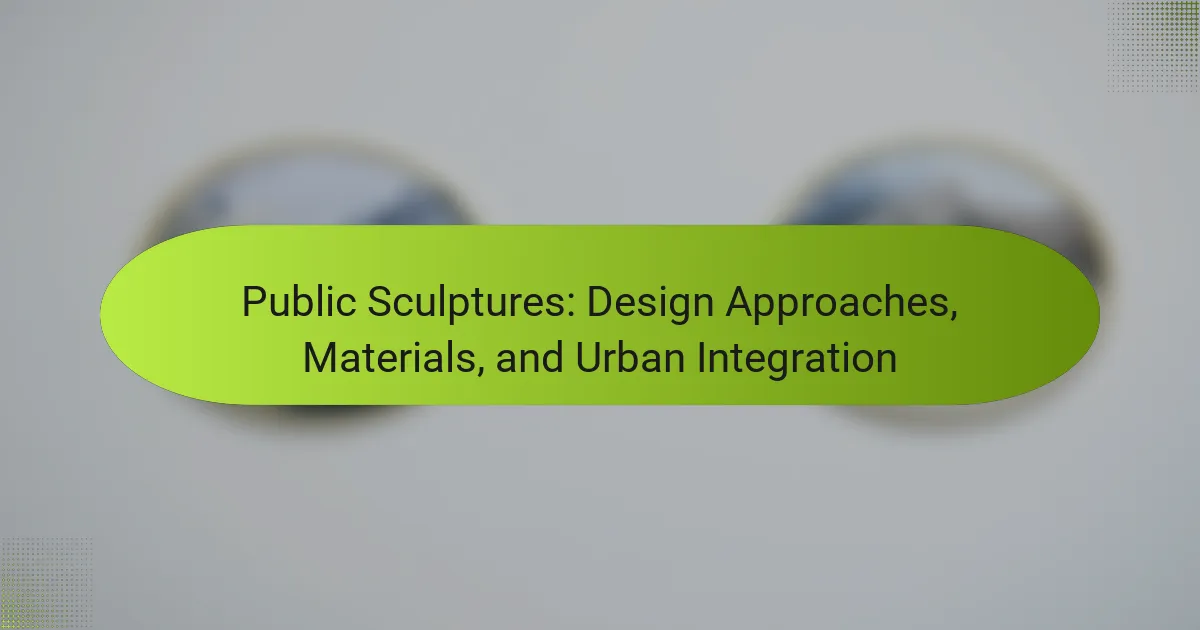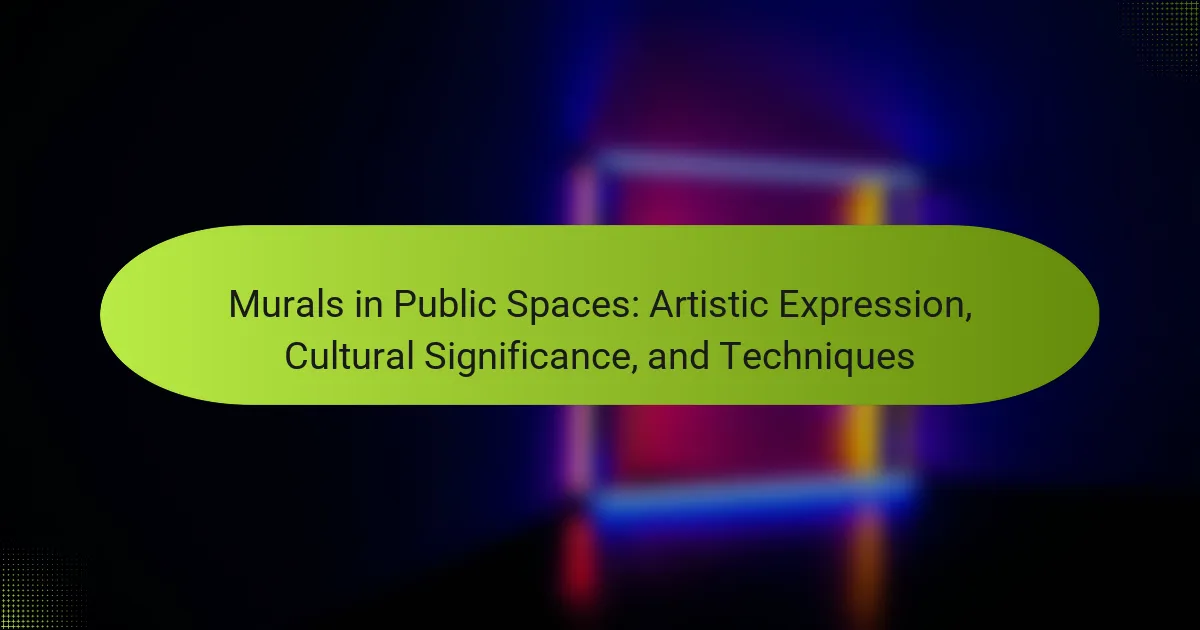Contemporary art installations offer interactive experiences that enhance visitor engagement. These installations utilize technology and immersive environments to create dynamic interactions. Locations vary widely, influencing how audiences connect with the art. Challenges artists face include technical limitations and funding constraints, while art institutions can enhance engagement through personalized experiences and collaborative installations.
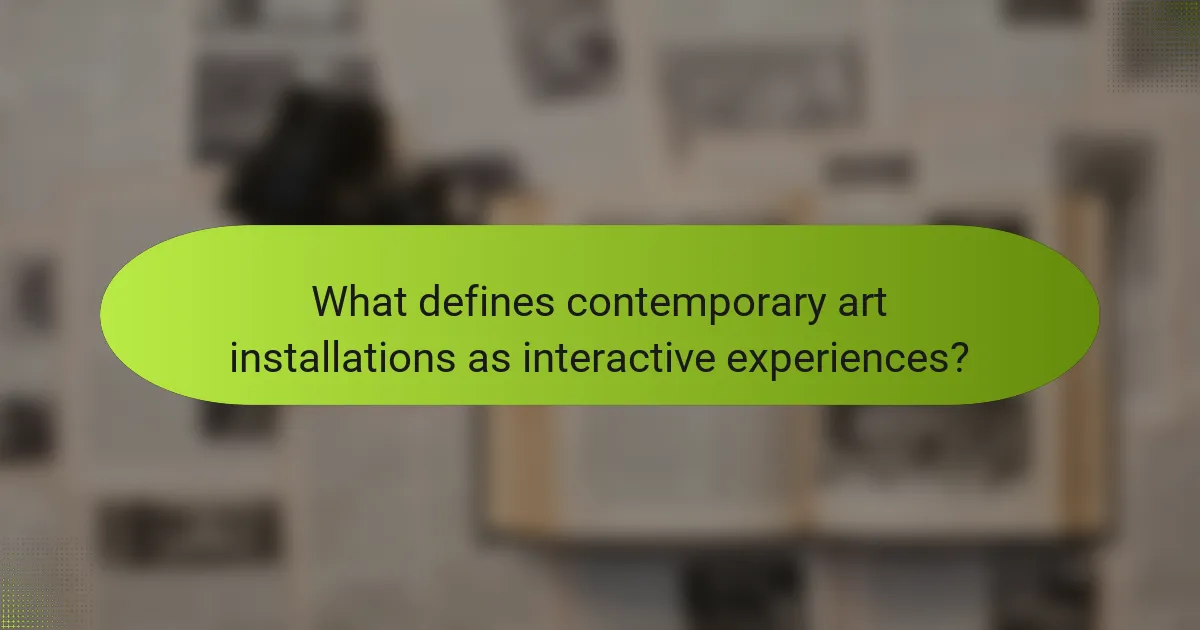
What defines contemporary art installations as interactive experiences?
Contemporary art installations are defined as interactive experiences that engage visitors through participation and sensory involvement. These installations often utilize technology, multimedia, and immersive environments to create dynamic interactions. Such engagement fosters a deeper connection between the artwork and the audience, transforming passive observation into active participation. Locations of these installations can vary widely, from galleries to public spaces, enhancing accessibility and community involvement.
How do interactive elements enhance visitor engagement?
Interactive elements significantly enhance visitor engagement by fostering participation and creating memorable experiences. These elements encourage visitors to actively interact with the art, deepening their emotional connection. For example, installations that incorporate touch, sound, or movement invite exploration and personal interpretation. This active involvement often leads to longer visit durations and increased visitor satisfaction. Moreover, unique attributes like augmented reality features can provide immersive experiences that transform traditional viewing into dynamic participation.
Why are sensory experiences crucial in contemporary art installations?
Sensory experiences are essential in contemporary art installations because they enhance visitor engagement and emotional connection. These experiences stimulate multiple senses, creating immersive environments that encourage interaction. For example, installations that incorporate sound, light, and tactile elements foster deeper appreciation and understanding of the artwork. As a result, visitors are more likely to form lasting memories and connections with the art. This unique attribute of sensory engagement distinguishes contemporary art installations from traditional forms, making them a vital aspect of modern artistic expression.
Which technologies are commonly used in interactive installations?
Common technologies in interactive installations include projection mapping, sensors, augmented reality, virtual reality, touch screens, and interactive software. These technologies enhance visitor engagement by creating immersive experiences. Projection mapping transforms surfaces into dynamic displays, while sensors detect visitor movements and interactions. Augmented and virtual reality offer unique environments for exploration. Touch screens provide intuitive interfaces for user interaction. Interactive software coordinates these elements, enabling seamless experiences.

How do different regions influence the perception of contemporary art installations?
Different regions significantly shape the perception of contemporary art installations through cultural context, historical significance, and local engagement. For instance, urban areas often emphasize interactive experiences, attracting diverse audiences. In contrast, rural regions may focus on community involvement, fostering unique visitor engagement. Regional art traditions influence installation styles, making them resonate differently across locations. Additionally, socio-political factors can alter interpretations, reflecting local values and concerns. This interplay creates a rich tapestry of experiences, highlighting the unique attributes of each region’s art scene.
What cultural factors shape visitor engagement in the UK?
Cultural factors significantly influence visitor engagement with contemporary art installations in the UK. Local traditions, historical context, and community involvement shape how audiences interact with art.
For example, public art projects often encourage community participation, enhancing engagement. The UK’s diverse cultural landscape fosters varied responses to interactive experiences, making engagement unique across regions.
Additionally, educational programs linked to installations can deepen visitor connections. These initiatives reflect the UK’s commitment to inclusivity and accessibility in the arts.
Overall, cultural factors create a dynamic environment that enriches visitor experiences in contemporary art settings.
How do American audiences respond to interactive art experiences?
American audiences generally respond positively to interactive art experiences. These installations enhance visitor engagement by allowing personal participation, fostering emotional connections. Locations such as museums and public spaces have embraced this trend, attracting diverse demographics. Studies indicate that interactive elements increase visitor satisfaction and dwell time, making art more accessible and relatable.
Which trends are emerging in European contemporary art installations?
Emerging trends in European contemporary art installations focus on interactive experiences, enhancing visitor engagement, and unique locations. Artists increasingly incorporate technology to create immersive environments. These installations often encourage audience participation, blurring the line between creator and viewer. Unique locations, such as abandoned buildings or public spaces, serve as backdrops, adding context and depth to the artworks. This trend reflects a shift towards community involvement and social commentary in the art world.
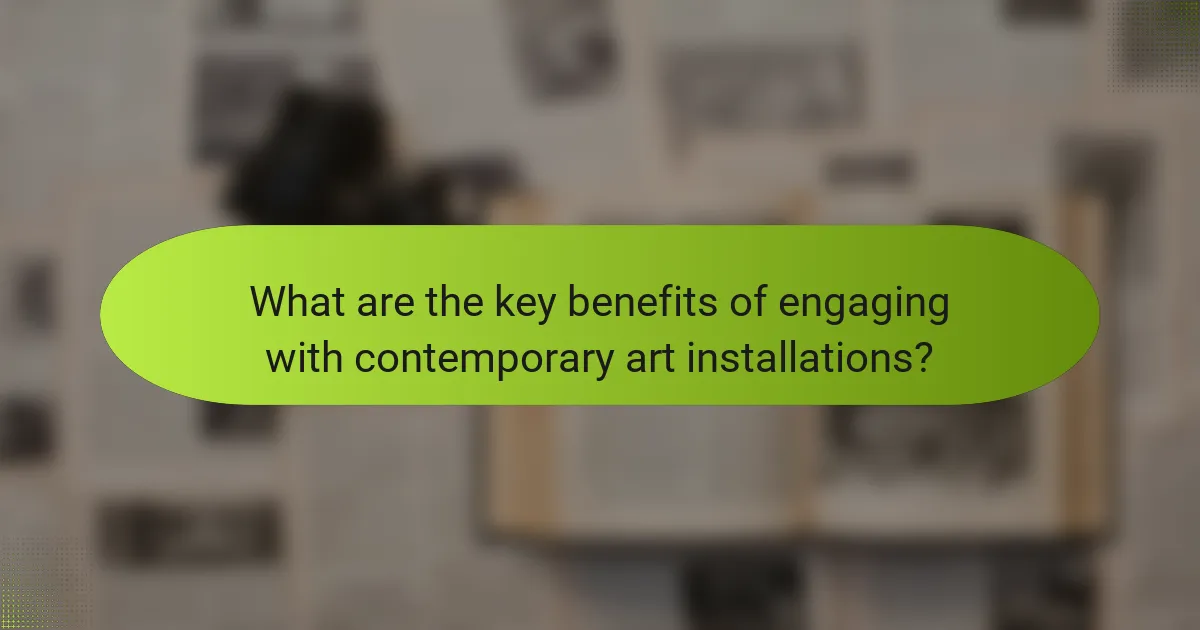
What are the key benefits of engaging with contemporary art installations?
Engaging with contemporary art installations offers numerous benefits, including enhanced visitor engagement, interactive experiences, and unique locations. These installations often stimulate creativity and provoke thought, encouraging deeper connections with art. They provide immersive environments that promote social interaction and community involvement. Additionally, contemporary art installations frequently challenge traditional perceptions of art, making them accessible and relatable to diverse audiences.
How does visitor participation enhance the overall experience?
Visitor participation significantly enhances the overall experience in contemporary art installations by fostering deeper engagement and interaction. Active involvement allows visitors to connect personally with the artwork, creating memorable experiences. This engagement can lead to increased emotional responses, encouraging discussions and reflections among attendees. Interactive elements, such as touchscreens or participatory installations, invite visitors to contribute, making them co-creators in the artistic process. As a result, the installation transforms from a passive viewing experience to an immersive journey, enriching the cultural dialogue surrounding contemporary art.
What impact do installations have on community and social interaction?
Contemporary art installations significantly enhance community and social interaction by fostering engagement and connection among visitors. These interactive experiences encourage participation, allowing individuals to express themselves and share perspectives. Moreover, installations often serve as communal spaces, promoting dialogue and collaboration. Locations hosting such installations become cultural hubs, attracting diverse audiences and strengthening community ties. As a result, contemporary art installations play a vital role in building social cohesion and enriching local culture.

Which notable contemporary art installations are recognized for their unique attributes?
Notable contemporary art installations recognized for their unique attributes include “The Obliteration Room” by Yayoi Kusama, “The Weather Project” by Olafur Eliasson, and “Infinity Mirror Rooms” also by Kusama. These installations emphasize interactivity, visitor engagement, and immersive experiences.
“The Obliteration Room” transforms a completely white space into a vibrant explosion of color as visitors add dot stickers, showcasing collective creativity. “The Weather Project” creates an artificial sun in a large space, inviting reflection on nature and perception. “Infinity Mirror Rooms” offers endless reflections, engaging viewers in a dialogue about infinity and self-exploration.
Each installation stands out for its unique ability to transform spaces and foster emotional connections with audiences. Their interactive nature encourages participation, making art accessible and engaging.
What makes certain installations iconic in the art world?
Certain installations become iconic due to their innovative engagement, emotional resonance, and unique locations. These factors create memorable experiences that resonate with audiences. For example, installations like “The Obliteration Room” by Yayoi Kusama invite visitor interaction, transforming spaces into immersive environments. Additionally, the location can enhance significance; installations in historic or culturally rich sites often attract more attention. Iconic installations leverage these attributes to create lasting impressions, making them central to contemporary art discourse.
How do location and context contribute to the uniqueness of specific installations?
Location and context significantly shape the uniqueness of contemporary art installations. The geographical setting influences the themes and materials used, reflecting local culture and history. Additionally, the context, such as social dynamics and environmental factors, affects visitor engagement and interaction. Installations may evolve based on seasonal changes or community events, creating a distinctive experience for each audience. For instance, an installation in an urban area may incorporate urban elements, while one in nature may emphasize organic materials. This interplay of location and context fosters a deeper connection between the artwork and its audience, enhancing the overall impact.
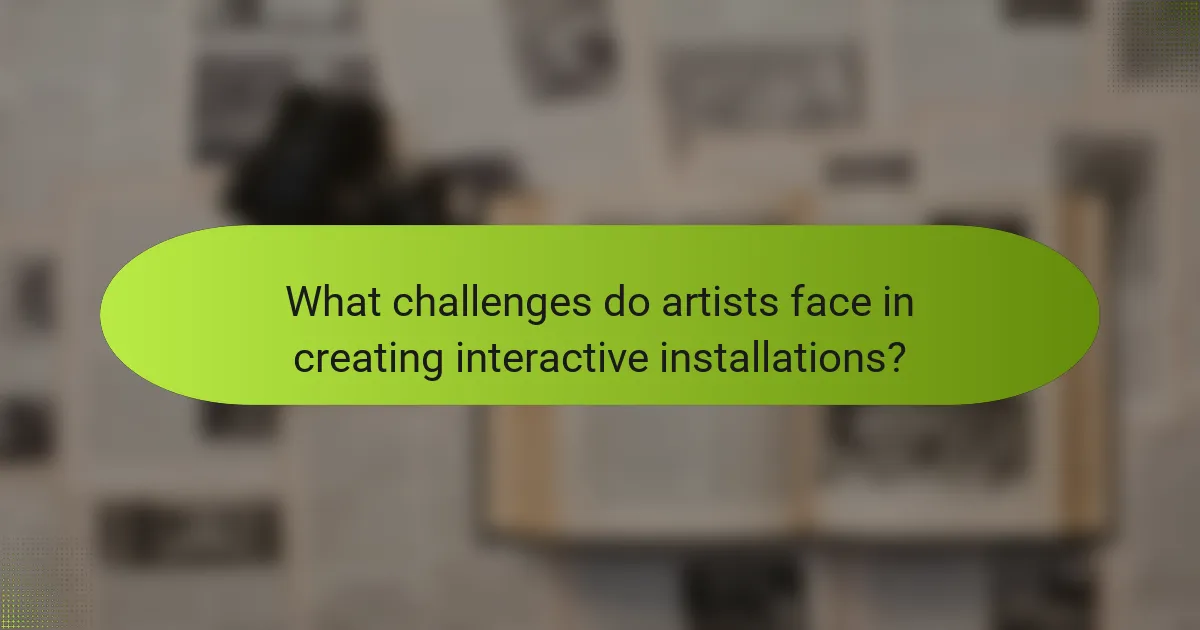
What challenges do artists face in creating interactive installations?
Artists face numerous challenges in creating interactive installations, including technical limitations, audience engagement, and funding constraints. Technical issues arise from the need for advanced technology that may not be readily available. Engaging visitors effectively can be difficult, as artists must balance artistic intent with user experience. Funding constraints can limit the scope and scale of installations, impacting creativity. Additionally, space limitations in venues can restrict the design and execution of interactive elements.
How do budget constraints affect the execution of art installations?
Budget constraints significantly limit the scope and scale of art installations. Artists often face challenges in materials, labor, and venue costs. Reduced funding can lead to simpler designs, fewer interactive elements, and diminished visitor engagement. Consequently, the overall impact of the installation may be less immersive, affecting the audience’s experience.
What are the common technical issues encountered during installation?
Common technical issues during installation of contemporary art installations include equipment malfunction, software compatibility problems, inadequate power supply, and environmental factors affecting the setup. These challenges can hinder visitor engagement and the overall experience. Proper planning and technical assessments can mitigate such issues effectively.
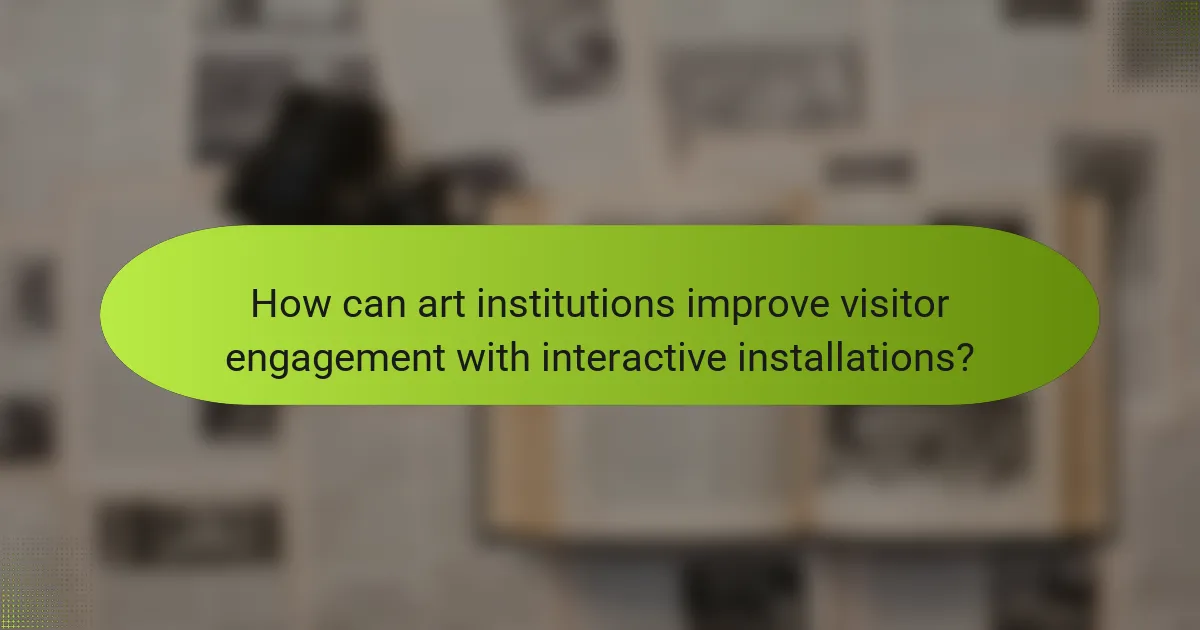
How can art institutions improve visitor engagement with interactive installations?
Art institutions can enhance visitor engagement through interactive installations by incorporating immersive technologies, fostering collaboration, and creating personalized experiences. Engaging visitors actively encourages exploration and deeper emotional connections with the artwork.
Utilizing augmented reality (AR) and virtual reality (VR) can transform passive viewing into an interactive experience. For instance, AR applications allow visitors to see additional layers of information or animations when viewing a piece, enriching their understanding and enjoyment.
Facilitating collaborative installations invites visitors to contribute creatively. This approach not only empowers individuals but also builds a sense of community among participants. For example, a mural where visitors can add their touch fosters a collective artistic expression.
Personalized experiences can be achieved through tailored content based on visitor preferences. Using data analytics, institutions can recommend installations that align with individual interests, enhancing the overall experience and encouraging repeat visits.
What strategies have proven effective in promoting visitor interaction?
Engaging visitors effectively in contemporary art installations requires interactive strategies. Utilizing immersive technology, such as virtual reality, enhances visitor experiences by making them active participants. Collaborative workshops allow visitors to create alongside artists, fostering a deeper connection to the art. Additionally, incorporating social media elements encourages visitors to share their experiences, amplifying engagement beyond the installation space. Finally, strategically designed spaces that invite exploration and interaction can significantly elevate visitor involvement.
Which best practices should be followed for optimizing visitor experiences?
To optimize visitor experiences in contemporary art installations, focus on interactivity, engagement, and strategic locations. Create immersive environments that encourage participation, utilize technology for enhanced interaction, and design spaces that foster social connections. Incorporate feedback mechanisms to adapt experiences based on visitor input, ensuring continuous improvement.
What common mistakes should be avoided in the design of interactive installations?
To design effective interactive installations, avoid these common mistakes: neglecting user experience, overcomplicating interactions, ignoring accessibility, and failing to test prototypes. These errors can diminish visitor engagement and the overall impact of the installation. Prioritize simplicity and inclusivity to enhance interaction.
